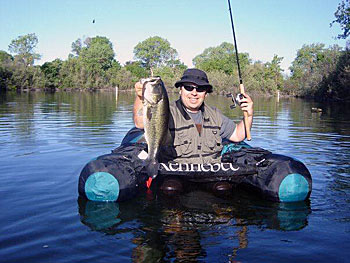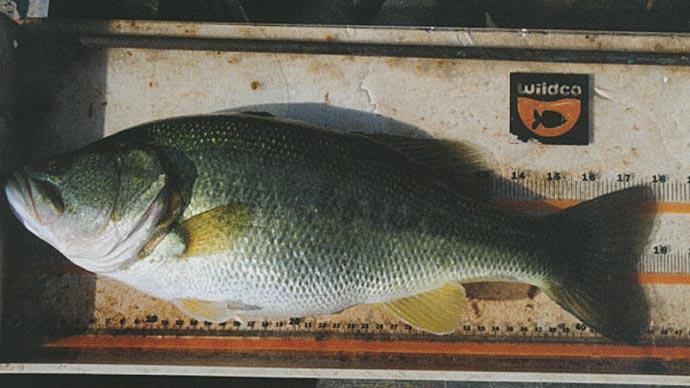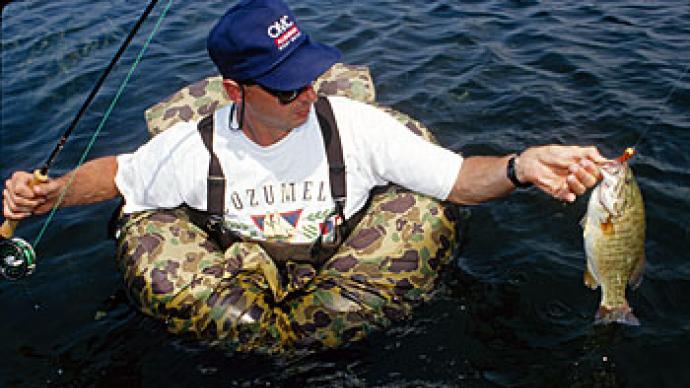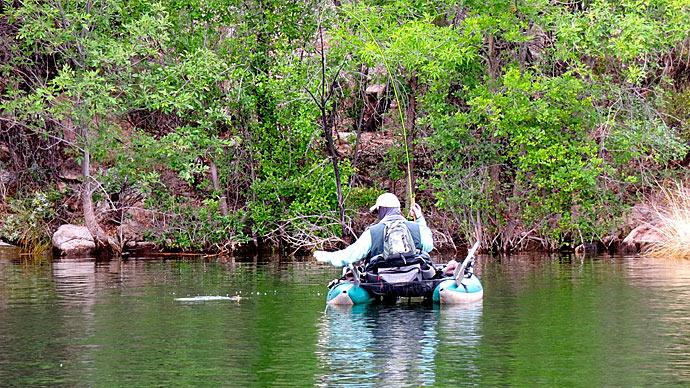
Where there is a will, there’s always a way, especially when it comes to bass fishing. Jeff Wilson and his friend were avid anglers, so they had plenty of will between them. But about a decade ago, they were searching for a way. “At the time, we couldn’t afford a boat,” he said.
The two found their solution through Bass-n-Tubes, a northern California bass club with about 40 members. It’s affiliated with The Bass Federation, and its members compete from float tubes, kick boats, or kayaks during club tournaments. Wilson purchased his first kick boat at a Costco Wholesale store about ten years ago, and he hasn’t stopped rowing and catching since. “It’s a whole lot of fun,” he said.
Kick boats are pretty simple. Parallel pontoons — inflatable or rigid — are connected by a perpendicular bench. There, the angler sits in a comfortable seat, and gear is stowed. They can be propelled manually or mechanically and are at home everywhere larger boats are used and in some places where they can’t venture. While their easy handling — during navigation, fishing, and onshore — is a big draw, their price, ranging from about $200 to about $700, might be their most attractive trait. That’s especially true compared to fiberglass bass boats, which can cost $50,000 or more.
Wilson said most club members choose kick boats over float tubes, also called belly boats. Shaped like an inner tube or horseshoe, a float tube angler — wearing waders and using flippers for propulsion — is suspended in the middle. “As [kick boats] came out, more went to them,” he said. That’s especially true of prospective members, who can fish their first club tournament for free. It’s a way for them to gauge their interest before paying dues. Some arrive with float tubes, but it’s not long before they are smitten with kick boats. “They say, ‘I’ve got to get one of those,” he said.

Kick boats are workhorses. Wilson said some heavy-duty models could carry up to about 450 pounds. “You can carry three to four times more tackle [than a float tube],” he said. He organizes his tackle in sealable containers, which keep his lures dry and makes them easy to swap out as conditions, seasons, and locations change. Some anglers carry a dozen rod-and-reel combos on their kick boats. “I [carry] a rod rack for six rods, a depth finder, and a livewell,” he said. While other human-powered fishing boats, such as kayaks, have been outfitted with fishing electronics and battery, the addition of a livewell is a kick boat-specific twist.
Kick boat livewells start with a container, most often a 48-quart cooler. A 500-gallon-per-hour bilge pump, powered by a small 12-volt battery — similar to the ones that power home alarms — runs the electronics, pumps fresh water into the cooler, and an aerator ensures it’s well oxygenated.
Wilson said kayakers in the club use livewells, too. They are usually strapped down behind the seat. Live-release tournaments are very different from most kayak tournaments, whose popularity is growing leaps and bounds. Nearly all follow a catch, photograph, and release procedure, with a judge looking at the photos, ruling on an official length of each catch, and declaring the angler with the most inches the winner.
Float tubes can’t carry a livewell, so the anglers who use them — along with some kick boat anglers — go a different route, lashing a follow-me bag to the side. The bags feature a PVC frame that sports floatation and is covered with mesh. They measure at least 10 inches tall, 18 inches wide, and 24 inches tall. Anglers place their bass inside, letting natural water flow to keep them healthy.
Most anglers make their follow-me bags slightly bigger for a good reason: Just because kick boats are small doesn’t mean you can’t catch big bass from them. Wilson’s largest is a 10.58-pounder. He caught it from the White Slough section of the California Delta, the maze of channels, rivers, and backwaters that’s well-known for producing giant bass. That stretch also produced the biggest five-bass limit in the club’s regular-season tournament history. It weighed 25.10 pounds.
It’s a good thing that kick boats can carry a lot of gear. Wilson says you can fish any technique from them that you can from a big boat. So drop shots, crankbaits and topwaters are all in play. He said many anglers like to pitch, flip and punch thick aquatic vegetation from their kick boats. They also are very stable. “I’ve had big boats come by, and you just sit there and ride their wakes,” he said. Some anglers push that stability further, choosing to stand while sight fishing for spawning bass, he said.

Kick boats are home on large bodies of water, which is apparent from the Bass-n-Tubes tournament schedule. “We try to mix it up,” Wilson said. “We fish the Delta most in the summer.” Members also fish Clear Lake, the almost 44,000-acre natural lake in northern California. At the club’s big two-day tournament last year, he said about 65 anglers fished, and it took 34 pounds to win.
Wilson said kick boats could also take you places bigger watercraft can’t venture. That opens up smaller lakes for tournaments and fun fishing. They also fit under docks and float in the shallowest coves.
There are three ways to move a kick boat across the water. The first is oars, which serve the same role as the outboard on a big boat. They are vital for traveling farther. “There are guys that go up to 3 or 4 miles,” Wilson said. Many row upwind, letting the breeze push them back to the launch. “You have to have the oars. Your legs would die with kicking with your feet,” he said.
Wilson switches to his feet once on the spot. Think of them as his trolling motor. With a few flicks of the attached flippers, he can hold steady against current or wind or move along as he fishes.
The third means of propulsion is the least used. On bigger bodies of water, such as Clear Lake, Wilson said some club anglers would forgo the livewell during tournament practice, instead carrying a bigger battery and attaching a trolling motor. It allows them to cover even more water. But the trolling motor must go on tournament day when people power is the only permitted means of propulsion.
Kick boats are easy to move around off the water, too. Wilson said while larger kick boats can weigh as much as 90 pounds, most tip the scale between 60 and 70 pounds. That’s about as much as smaller basic kayaks. If you’re fishing with your buddy, you can help each other carry them to the water’s edge. He said there also are dollies specially designed to roll kick boats around. What you most likely won’t need is a trailer. He puts his kick boat in his truck’s bed.
Kick boat anglers sit in the water but not as deep as those who use float tubes. It still necessitates the use of waders. Wilson wears a short pair — akin to wading pants — during warmer weather, switching to chest waders when water and air temperatures dip. He forgoes traditional wading boots, choosing tennis shoes instead. He wears his flippers over them.
Bass-n-Tubes isn’t the only kick boat club in California. The Sonoma County Belly Boat Bass Club, affiliated with B.A.S.S. Nation, holds tournaments, too. Many kick boat anglers also own big boats, and Wilson, who serves as Bass-n-Tubes president, fishes California TBF tournaments. Some members have used the club as a springboard to higher levels of competition.
Chris Zaldain, who competes in the Bassmaster Elite Series, belonged to Bass-n-Tubes when Wilson first joined the club. And Michael Alaga and Clayton Galassi recently fished the Student Angler Federation High School National Championship on Alabama’s Pickwick Lake in late June. The organizer, which hosts high-school tournaments nationwide, is affiliated with The Bass Federation. Alaga hasn’t left his kick boat roots. Wilson said he finished fourth in the club’s big mid-July tournament on the California Delta.
Wilson said the club offers the perfect opportunity for anyone who wants to fish more and compete in tournaments, especially young anglers. “They can’t afford a big boat, but they can afford a $200 kick boat,” he said. He said the club also covers membership fees for anglers younger than 18. That opens the door for them to compete in high school, team, and other affiliated tournaments.




